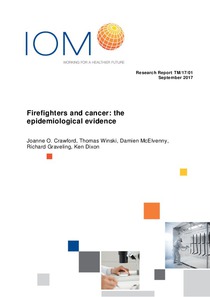Firefighters and cancer: the epidemiological evidence
"It is recognised that firefighters can be exposed to many different harmful substances. In 2007 the International Agency for Research on Cancer convened a working group to assess the carcinogenicity of a variety of occupations, increased rates of testicular, prostate and non-Hodgkin’s lymphoma...
| Main Authors: | , , , , , , |
|---|---|
| Institution: | ETUI-European Trade Union Institute |
| Format: | TEXT |
| Language: | English |
| Published: |
Edinburgh
2017
IOM |
| Subjects: | |
| Online Access: | https://www.labourline.org/KENTIKA-19395316124911135989-Firefighters-and-cancer-the-ep.htm |
| _version_ | 1771659898476560385 |
|---|---|
| author | Institute of Occupational Medicine, Edinburgh Crawford, Joanne Winski, Thomas McElvenny, Damien M. Graveling, Richard A. Dixon, Ken Cowie, Hilary A. |
| author_facet | Institute of Occupational Medicine, Edinburgh Crawford, Joanne Winski, Thomas McElvenny, Damien M. Graveling, Richard A. Dixon, Ken Cowie, Hilary A. |
| collection | Library items |
| description | "It is recognised that firefighters can be exposed to many different harmful substances. In 2007 the International Agency for Research on Cancer convened a working group to assess the carcinogenicity of a variety of occupations, increased rates of testicular, prostate and non-Hodgkin’s lymphoma were identified for firefighting. This report examines the research published since an IOM review for the UK Industrial Injuries Advisory Council, by carrying out a systematic review and meta-analyses of the epidemiological evidence for specific cancers in firefighters. In total 304 publications were screened against the inclusion criteria, 261 publications were excluded based on their title/abstract and a further 20 were excluded once the full publication had been examined. The remaining 23 papers were included in the review. Meta-analyses were carried out for 23 specific cancer sites. Cancers identified as having a positive association with firefighting included colon (meta-RR=1.18, 95% CI 1.08-1.29), rectal (meta-RR=1.16, 95% CI 1.05-1.29), lymphatic and haematopoietic (meta-RR=1.20, 95% CI 1.07-1.35), non-Hodgkin’s lymphoma (meta-RR=1.14, 95% CI 1.05-1.23), melanoma (meta-RR=1.41, 95% CI 1.21-1.65), prostate (meta-RR=1.13, 95% CI 1.03-1.24), bladder (meta-RR=1.12, 95% CI 1.01-1.26) and kidney cancer (meta-RR=1.16, 95% CI 1.00-1.23). The report highlights that a number of cancers were identified as having a raised risk among firefighters, but there was no evidence in this literature of the association found previously with testicular cancer. " |
| format | TEXT |
| id | 19395316124911135989_22b0bed450db4508bf847564732e106f |
| institution | ETUI-European Trade Union Institute |
| is_hierarchy_id | 19395316124911135989_22b0bed450db4508bf847564732e106f |
| is_hierarchy_title | Firefighters and cancer: the epidemiological evidence |
| language | English |
| physical | 57 p. Digital |
| publishDate | 2017 |
| publisher | Edinburgh IOM |
| spellingShingle | Institute of Occupational Medicine, Edinburgh Crawford, Joanne Winski, Thomas McElvenny, Damien M. Graveling, Richard A. Dixon, Ken Cowie, Hilary A. occupational disease cancer fire fighter occupation disease relation toxic substances exposure epidemiologic study literature survey Firefighters and cancer: the epidemiological evidence |
| thumbnail | https://www.labourline.org/Image_prev.jpg?Archive=131020295920 |
| title | Firefighters and cancer: the epidemiological evidence |
| topic | occupational disease cancer fire fighter occupation disease relation toxic substances exposure epidemiologic study literature survey |
| url | https://www.labourline.org/KENTIKA-19395316124911135989-Firefighters-and-cancer-the-ep.htm |

